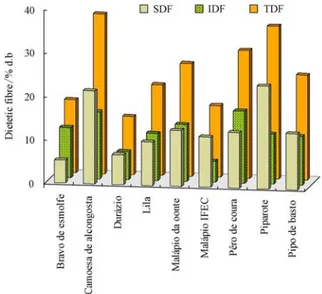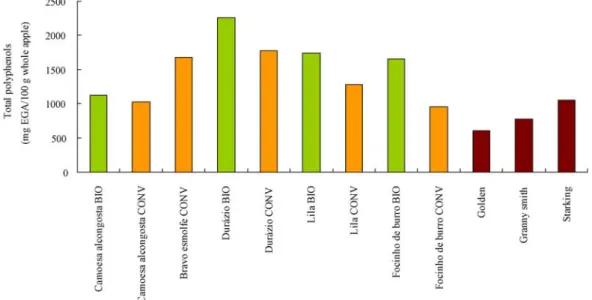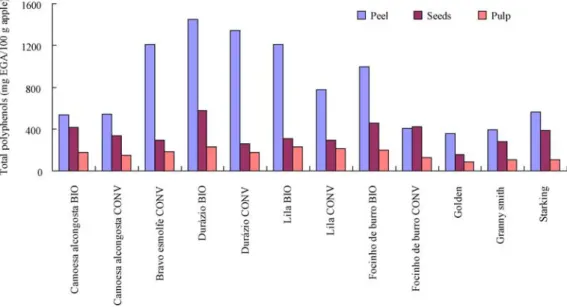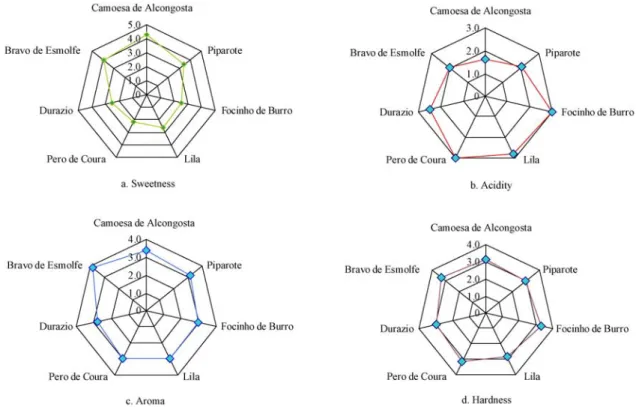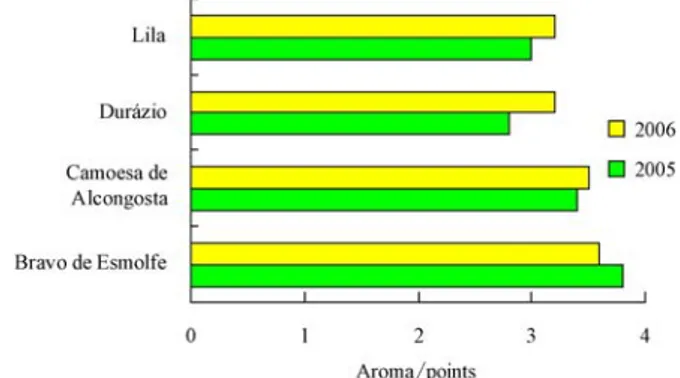Phenolic, dietetic fibre and sensorial analyses of apples from
regional varieties produced in conventional and biological mode
Guiné R P F
1, Sousa R
2, Alves A
2, Teixeira L
2, Figueiredo C
2, Fonseca S
2, Soares S
2,
Sousa I
2, Almeida P
2, Correia A C
2, Jordão A M
1, Lopes A D
3, Ferreira D
1(1. CI & DETS, Instituto Politécnico de Viseu, ESAV, Portugal;
2. Instituto Politécnico de Viseu, ESAV, Portugal;
3. Direcção Regional de Agricultura e Pescas do Centro, DSAP, DPAP, Viseu, Portugal)
Abstract: In the present work apples from eleven regional varieties originating from Portugal were studied in terms of their
content in phenolic compounds and dietetic fibres (soluble and insoluble). In some cases, apples from two different production modes were analysed: conventional and biological. Some of the most commercialized apples in Portugal were also studied for comparison purposes. In addition, a sensorial evaluation of some of the varieties was performed. From the present work it was possible to conclude that the regional varieties studied contain higher amounts of dietetic fibre than those of commercial varieties and other fruits. With respect to the content in total phenolic compounds, the apples of regional varieties showed values clearly higher than those quantified in commercial varieties, and being concentrated mainly on the peel, then on the seeds, and finally on the pulp. From the sensorial analyses was possible to infer that the regional varieties which were more appreciated were Bravo de Esmolfe and Camoesa de Alcongosta.
Keywords: apple, conventional production, biological production, soluble fibre, insoluble fibre, polyphenols, sensorial analysis, portugal
Citation: Guiné R P F, Sousa R, Alves A, Teixeira L, Figueiredo C, Fonseca S, Soares S, Sousa I, Almeida P, Correia A C, Jordão A M, Lopes A D, Ferreira D. Phenolic, dietetic fibre and sensorial analyses of apples from regional vareties produced in conventional and biological mode. Agric Eng Int: CIGR Journal, 2010, 12(2): 70-78.
1 Introduction
As apple production has intensified over the last decades, the concerns about the excessive applications of chemicals have increased (Sina, 2006), both on the point of view of the environment and of the product quality. Thus, organic management practices, which exclude the usage of chemical pesticides and fertilizers and in alternative use the naturally derived products (Glover, 2000), have become more common.
More and more regional food patrimony is of crucial importance to the development of rural areas, moreover
Received date: 2009-08-17 Accepted date: 2010-01-04 Corresponding author: Guiné R P F, ESAV, Quinta da Alagoa,
Estrada de Nelas, 3500-606 Viseu, Portugal, tel: +351 232 446600, fax: +351 232 426536, Email: raquelguine@esav.ipv.pt
when the products gather together the advantages of having particular characteristics, sometimes more valued by the consumers, with the advantages of having in their composition certain molecular components that have been proved to promote health. Among these, the fundamental role of phenolic compounds and fibres, particularly dietetic fibre, is highlighted.
Fruits, vegetables, wholemeal bread, nuts and cereals, specially the whole cereals, are examples of foods rich in dietetic fibres. The occidental diet has become poor in dietetic fibres, as a consequence of the consumption of refined foods. This, associated to unhealthier lifestyles, with little or no exercise, has led to the spread of health problems. The ingestion of adequate amounts of fibres is associated with a reduction in the incidence of some diseases such as diabetes (Hannan, 2007; Maki, 2007),
obesity (Grunberger, 2007; Murakami, 2007), constipation (Castillejo, 2006; Hongisto, 2006), cholesterol and heart diseases (van Rosendaal, 2004; Adebawo, 2006; Salas-Salvado, 2006; Queenan, 2007) and colon cancer (Wakai, 2007). Insoluble dietetic fibre increases the moisture and volume of faeces and facilitates intestinal mobility, thus promoting a healthy functioning of the intestine and preventing the development of colon diseases (Guillon, 2000). Soluble dietetic fibres tend to reduce the absorption of cholesterol in the intestine, and therefore its level in the blood, contributing to the reduction in the risk of cardiovascular diseases. The soluble fibres originate fermentation reactions, producing high concentrations of specific substances that work as energy sources to the mucous membrane and as protecting agents to diseases like cancer and ulcerative colitis (Topping, 2007).
Apples have in their composition bioactive phenolic compounds of the flavonoids class, where the carotenoids are included, that make this fruit a product of superior quality (Férnandez-Ginéz, 2003; Sudha, 2007). The phenolic compound presented in apple may have antioxidant activity, beneficial to health, and contribute to a balanced diet. Flavonoids constitute a group of phenolic compounds very abundant in some foods, with proved benefits in the prevention of cardiovascular diseases, cancer and chronic diseases (Hagen, 2006). Vegetables and fruits, in particular, are very rich in phenolic compounds, namely phenolic acids and flavonoids. Although they are not essential for the functioning of the human body, they allow a higher protection against a high number of diseases, such as atherosclerosis (Mullen, 2007). The flavonoids have been arising from considerable interest due to their potential benefits to human health, namely antiviral, antitoxic, anti-fungal (Friedman, 2007), antibacterial (Moller, 2006; Zhou, 2007), anti-allergic (Kawai, 2007), anti-inflammatory (Nowakowska, 2007), anti-cancer (Gates, 2007; Theodoratou, 2007) and antioxidant activities (Shahidi, 2004).
In Portugal a great number of regional varieties of apples can still be found and these constitute a patrimony that must be preserved and promoted. However, these regional varieties are not known in terms of their
properties and potentialities, and therefore some work has been done in Portugal in order to characterize these varieties.
In the present work apples from regional varieties originating from Portugal were studied in respect of their composition in soluble and insoluble dietetic fibre and phenolic compounds. An organoleptic taste was also performed to evaluate the sensorial attributes of the apples.
2 Materials and methods
In the present study eleven varieties of regional apples from Portugal were analysed: Bravo de Esmolfe,
Camoesa de Alcongosta, Durázio, Focinho de Burro, Lila, Malápio da Ponte, Malápio do IFEC, Pardo Lindo do IFEC, Pêro de Coura, Piparote, Pipo de Basto. In some
cases, apples from two different production modes were used: conventional and biological. Some apples from commercial varieties very much consumed in Portugal were also studied for comparison purposes: Golden Delicious, Starking and Granny Smith.
For the analysis of the dietetic fibre content, only the pulp of the fruit was used and in each case the determinations were made in duplicate. For the analysis of total phenolic content, different parts of the fruit were used separately: peel, pulp and seeds.
Dietetic fibre was quantified following the methodology described by Prosky et al. (1988).
In respect to total phenolic content, the method Folin-Ciocalteau was followed as described by Singleton & Rossi (1965). The results were expressed in units of equivalents of garlic acid.
The sensorial analysis was made with a trained panel of 18 elements, and sensorial attributes tested were: colour, sweetness, acidity, aroma, hardness, uniformity, visual aspect and global appreciation. To evaluate each attribute, a numerical scale was used, varying between one (lower valorisation) and five (higher valorisation).
3 Results and discussion
The total, soluble and insoluble fibre contents of apples from regional varieties, in the 2005 harvest are presented in Figure 1. In general, the varieties studied present values of total dietetic fibre higher than those
found for commercial varieties of apples, and other fruits like pears or oranges, particularly in respect to soluble dietetic fibre (Li, 2002). In commercialized apples and pears, the greatest fraction of dietetic fibre is represented by insoluble fibre (Li, 2002). From the varieties analysed, the insoluble dietetic fibre is higher than the soluble only for four varieties (Bravo de Esmolfe, Lila,
Malápio da Ponte and Pêro de Coura). For the other
varieties the soluble fibre content is higher than the insoluble fibre content. Compared to some cereals and derived products, it is concluded that most of the regional varieties of apples present higher contents of soluble dietetic fibre, and therefore they may be considered a good alternative to cereals in respect to this component (Li, 2002; Grigelmo-Miguel, 1999).
Figure 1 Dietetic fibre content of apples from regional varieties, produced in conventional mode, in 2005 harvest. Results expressed
in dry basis. SDF, soluble dietetic fibre; IDF, insoluble dietetic fibre and TDF, total dietetic fibre
In Figure 2 the total dietetic fibre contents are shown for regional varieties of apples, produced in conventional mode, during the three consecutives harvesting years of 2004, 2005 and 2006.
From the graph it is visible that the varieties Piparote and Camoesa de Alcongosta are those richer in dietetic fibre, and that Durázio is the one that presents less dietetic fibre content. When comparing the three years, it is possible to see higher resemblances between the years 2004 and 2005, and that the year 2006 is that when the total dietetic fibre contents is much smaller than almost all varieties. The only exception is the variety
Durázio.
Figure 2 Variation of total dietetic fibre of apples from regional varieties produced in conventional mode comparing harvests of
three years. Results expressed in dry basis
Figure 3 shows the variations of soluble dietetic fibre content along the three years of study, and once more the year 2006 was that when the contents were significantly lower when compared to the other two years. The varieties richer in soluble fibre are Piparote and Camoesa
de Alcongosta.
Figure 3 Variation of soluble dietetic fibre of apples from regional varieties produced in conventional mode comparing
harvests of three years. Results expressed in dry basis
In Figure 4 the insoluble dietetic fibre content is presented for the three years, 2004 to 2006, and again the results from 2004 and 2005 are very similar. The varieties richer in insoluble fibre are Pêro de Coura and
Figure 4 Variation of insoluble dietetic fibre of apples from regional varieties produced in conventional mode comparing
harvests of three years. Results expressed in dry basis
In respect to the contents in phenolic compounds present in the different regional varieties of apples that were objected of study (Figure 5), the results point out to the presence of higher values of total polyphenols in the varieties Durázio, Bravo de Esmolfe, Lila and Focinho de
Burro, being that particularly true for this last variety in
the biological production mode. It is worth mentioning that all the regional varieties studied present values of total polyphenols clearly higher in relation to those quantified in varieties with higher commercial importance, like for instance Golden. These results present a good perspective for the increase in the consumption of regional varieties of apples to the detriment of varieties with higher commercial expression, as a means of an increase the intake of these beneficial components. Still considering Figure 5, it is possible to observe that the type of production (conventional or biological) has some influence in the total polyphenol contents, being the biological production mode the one that allows the richer content in phenolic compounds. In fact, for all varieties the values encountered for the apples produced by biological mode are higher than those for the apples produced by conventional mode. This is also an important conclusion, since the option for the biological production presents advantages concerning the quality of the fruits produced, besides all the environmental advantages associated to these production techniques.
Figure 5 Medium values of total polyphenols in the pulp of apples from regional varieties in the 2005 harvest, produced in conventional (CONV) and biological (BIO) mode. Comparison with commercial apples. Results expressed in equivalents of galic acid (EGA)
In relation to the distribution of the total polyphenols in the fruit, peel, seeds or pulp, the results presented in Figure 6 show that in all the varieties studied the peel is that portion of the apple where the major part of polyphenols is concentrated, followed by the seeds and last by the pulp. These results are in agreement with
those encountered by Lata et al (2009), which state that the peel is a significant contributor to the phenolics present in the 19 apple cultivars they analysed.
Also the findings of Drogoudi et al (2008) from a study that included seven apple cultivars state that apple peel contain from 1.5 to 9.2 times greater total
antioxidant activity and from 1.2 to 3.3 times greater total phenolic content compared with flesh. The values of total polyphenols encountered in the peel are higher when the apples are produced in biological mode, as seen before in Figure 5, being this difference particularly accentuated in the varieties Lila and Focinho de Burro. However, it is in these varieties that the differences between conventional or biological modes are less significant as it concerns the polyphenols present in the seeds. When the regional varieties are compared to the commercialized ones (Golden, Granny Smith or Starking) once more the regional varieties are highlighted for containing higher amounts of polpyphenols. The results
also allowed seeing that, just after the peel, the seeds is the apple portion where the majority of the phenolic compounds is concentrated. These results are in accordance with works done with other fruits, which concluded that the seeds have a great potential in terms of polyphenols, like in the case of grapes (Fuleki, 1997; Jordão, 2001). The fact that these parts present a high potential in terms of polyphenols, may lead to an economical valorisation of these otherwise rejected parts of the fruit, as a source of phenolic compounds to several types of industry, such as pharmaceutical or cosmetic industries, besides food industry.
Figure 6 Medium values of total polyphenols in different parts (peel, pulp and seeds) of apples from regional varieties in the 2005 harvest, produced in conventional (CONV) and biological (BIO) mode. Comparison with commercial apples. Results expressed in equivalents of
galic acid (EGA)
Figures 7 and 8 present the results obtained in the sensorial analysis made to the different regional varieties in the 2005 harvest. In this year, in sensorial terms the varieties that are highlighted are Bravo de Esmolfe and
Camoesa de Alcongosta (Figure 7), both from
conventional production. These varieties, produced in conventional mode, were considered the sweeter and more aromatic from the elements of the panel (Figure 8). In respect to acidity the varieties considered more acid were Focinho de Burro, Lila, Pêro de Coura and Durázio, whereas the less acid of all was precisely Camoesa de
Alcongosta, one of the most appreciated in global terms,
as seen previously from Figure 7.
Figure 7 Global appreciation from sensorial analysis performed to apples from regional varieties, produced in conventional (CONV)
Figure 8 Results from sensorial analysis relative to the attributes: sweetness, acidity, aroma and hardness, of apples from regional varieties, produced in conventional mode, in the 2005 harvest
In relation to the sensorial attribute hardness, no significant differences were encountered between the various apples analysed.
In the year 2006, only three varieties of apples were studied in both production modes, conventional and biological: Pipo de Basto, Malápio da Ponte and Pardo
Lindo (Figure 9).
Figure 9 Global appreciation from sensorial analysis performed to apples from regional varieties, produced in conventional (CONV)
and biological (BIO) modes, in the 2006 harvest
The variety Bravo de Esmolfe was analysed only in conventional production mode, because the trees in biological mode did not produce apples in that year. With respect to global appreciation, the variety Pardo Lindo (in
both production modes) together with Bravo de Esmolfe (conventional) were the most appreciated, because they were considered the sweetest, less acid, more aromatic and with a more cohesive texture (data not presented). The variety Bravo de Esmolfe (conventional) was also valued in terms of colour and visual aspect, as well as uniformity (Figure 10).
The variety Pardo Lindo (conventional and biological) was considered good in relation to there three sensorial attributes. The variety Pipo de Basto was highly valued in colour (both production modes) and visual aspect (only conventional mode) but less valued in terms of uniformity.
Figures 11 and 12 show the comparison between some results obtained in 2005 with those obtained in 2006, for apples produced in conventional mode (Bravo
de Esmolfe, Camoesa de Alcongosta, Durázio and Lila).
The results demonstrate that the varieties Bravo de
Esmolfe and Camoesa de Alcongosta were the most
appreciated in global terms by the elements of the panel, in these two years (Figure 11), being also those that were more valued in terms of the sensorial attribute aroma as can be seen in Figure 12. As to the effect of the harvest
year on the sensorial characteristics of the apples, it was observed that the global appreciation was not very different in 2005 and 2006 in almost all the varieties,
except for Durázio (Figure 11), and that the appreciation of aroma was similar in both years for all varieties (Figure 12).
Figure 10 Results from sensorial analysis relative to the attributes: colour, uniformity and visual aspect of apples from regional varieties, produced in conventional (CONV) and biological (BIO) modes, in the 2006 harvest
Figure 11 Comparison of global appreciation from sensorial analysis performed to apples of regional varieties, in conventional
production mode, in the 2005 and 2006 harvest.
Figure 12 Comparison of the sensorial analysis to the attribute aroma, performed to apples of regional varieties, in conventional
production mode, in the years 2005 and 2006.
4 Conclusions
From the present work it was possible to conclude that the regional varieties studied presented a high potential, partly because of their high contents in dietetic fibre, higher than those found for commercial apples and other fruits, and also because of their soluble fibre content that it was higher than the insoluble one.
One other aspect that helps to value these apples is
their high contents in phenolic compounds, with values clearly higher than those quantified in commercial apples. Still, it is possible to observe that the type of production (conventional or biological) has some influence in the total polyphenol contents, being the biological production mode the one that allows to obtain apples richer in phenolic compounds. As to the way the total polyphenols are distributed in the fruit, the peel is where the higher amount can be found, followed by the seeds
and finally the pulp.
From the sensorial analyses was possible to infer that the apples produced in conventional mode were more appreciated, indicating that still some improvements, such
as visual aspects, are needed in the production in biological mode. In sensorial terms the varieties that are more appreciated were Bravo de Esmolfe and Camoesa
de Alcongosta.
References
Adebawo, O., B. Salau, E. Ezima, O. Oyefuga, E. Ajani, G. Idowu,A. Famodu, and O. Osilesi. 2006. Fruits and vegetables moderate lipid cardiovascular risk factor in hypertensive patients. Lipids Health Dis., 5: 14.
Castillejo, G., M. Bullo, A. Anguera, J. Escribano, J. Salas-Salvado. 2006. A controlled, randomized, double-blind trial to evaluate the effect of a supplement of cocoa husk that is rich in dietary fiber on colonic transit in constipated pediatric patients. Pediatrics, 118(3): e641-e648.
Drogoudi, P. D., Z. Michailidis, and G. Pantelidis. 2008. Peel and flesh antioxidant content and harvest quality characteristics of seven apple cultivars. Scientia Horticulturae, 115, 149- 153.
Fernández-Ginéz, J. M., J. Fernández-López, E. Sayas-Barberá, and J. A. Pérez-Alvarez. 2003. Effects of storage conditions on quality characteristics of bologna sausages made with citrus fibre. Journal of Food Science, 68, 710-715.
Friedman, M. 2007. Overview of antibacterial, antitoxin, antiviral, and antifungal activities of tea flavonoids and yeas. Mol Nutr Food Res, 51(1): 116-134.
Fuleki, T. and J. M. Ricardo da Silva. 1997. Catechin and procyanidin composition of seeds from grape cultivars grown in Ontario. J. Agric. Food Chem, 45(4): 1156-1160.
Gates, M. A., S. S. Tworoger, J. L. Hecht, I. De Vivo, B. Rosner, and S. E. Hankinson. 2007. A prospective study of dietary flavonoid intake and incidence of epithelial ovarian cancer. Int J Cancer, 121(10): 2225-2232.
Glover, J. D., J. P. Reganold, and P. K. Andrews. 2000. Systematic method for rating soil quality of conventional, organic, and integrated apple orchards in Washington State. Agriculture, Ecosystems & Environment, 80(1-2): 29-45. Grigelmo-Miguel, N. and O. Martin Belloso. 1999. Comparison
of Dietary Fibre from By-products of Processing Fruits and Greens and from Cereals. Lebensm.-Wiss. u.-Technol., 32, 503-508.
Grunberger, G., K. L. Jen, and J. D. Artiss. 2007. The benefits of early intervention in obese diabetic patients with FBCx: a new dietary fibre. Diabetes Metab Res Rev, 23(1): 56-62. Guillon, F. and M. Champ. 2000. Structural and physical
properties of dietary fibres, and consequences of processing on
human physiology. Food Research International, 33, 233- 245.
Hagen, S. F., K. A. Solhaug, G. B. Bergtsson, G. I. A. Borge, and Bilger W. 2006. Chlorophyll fluorescence as a tool for non-destructive estimation of anthocyanin and total flavonoids in apples. Posthavest Biolo. And Tech, 41, 156-163. Hannan, J. M., L. Ali, B. Rokeya, J. Khaleque, M. Akhter, P. R.
Flatt, and Y. H. Abdel-Wahab. 2007. Soluble dietary fibre fraction of Trigonella foenum-graecum (fenugreek) seed improves glucose homeostasis in animal models of type 1 and type 2 diabetes by delaying carbohydrate digestion and absorption, and enhancing insulin action. Br J Nutr, 97(3): 514-521.
Hongisto, S. M., L. Paajanen, M. Saxelin, R. Korpela. 2006. A combination of fibre-rich rye bread and yoghurt containing Lactobacillus GG improves bowel function in women with self-reported constipation. Eur. J. Clin. Nutr., 60(3): 319- 324.
Jordão, A. M., J. M. Ricardo da Silva, and O. Laureano. 2001. Evolution of catechin and procyanidin composition during grape maturation of two varieties (Vitis vinifera L.) Castelão Francês and Touriga Francesa. Am J Enol. Vitic, 52, 230- 234.
Kawai, M., T. Hirano, S. Higa, J. Arimitsu, M. Maruta, Y. Kuwahara, T. Ohkawara, K. Hagihara, T. Yamadori, Y. Shima, A. Ogata, I. Kawase, and T. Tanaka. 2007. Flavonoids and related compounds as anti-allergic substances. Allergol. Int., 56, 2.
Lata, B., A. Trampczynska, and J. Paczesna. 2009. Cultivar variation in apple peel and whole fruit phenolic composition. Scientia Horticulturae (in press).
Li, B., K. K. Andrews, and P. Pehrsson. 2002. Individual Sugars, Soluble and Insoluble Dietary Fiber Contents of 70 High Consumption Foods. Journal of Food Composition and Analysis, 15, 715-723.
Maki, K. C., M. L. Carson, M. P. Miller, M. Turowski , M. Bell, D. M. Wilder, and M. S. Reeves. 2007. High-viscosity hydroxypropylmethylcellulose blunts postprandial glucose and insulin responses. Diabetes Care, 30, 1039-1043.
Sporer, J. Reichling, and M. Wink . 2006. Antibacterial, antiviral, antiproliferative and apoptosis-inducing properties of Brackenridgea zanguebarica (Ochnaceae). J Pharm Pharmacol, 58(8): 1131-1138.
Mullen, W., S. C. Marks, and A. Crozier. 2007. Evaluation of phenolic compounds in commercial fruit juices and fruit drinks. J Agric Food Chem, 55, 3148-3157.
Murakami, K., S. Sasaki, H. Okubo, Y. Takahashi, Y. Hosoi, and M. Itabashi. 2007. Dietary fiber intake, dietary glycemic index and load, and body mass index: a cross-sectional study of 3931 Japanese Women Aged 18-20 years. Eur. J. Clin. Nutr., 61, 986-995.
Nowakowska, Z. 2007. A review of anti-infective and anti-inflammatory chalcones. Eur J Med Chem., 42(2): 125- 137.
Prosky, L., N. G. Asp, F. Schweizer, W. DeVRIES, and I. Furda. 1988. Determination of insoluble, soluble, and total dietary fiber in foods and food products: interlaboratory study. J Assoc Off Anal Chem., 71(5): 1017-1023.
Queenan, K. M., M. L. Stewart, K. N. Smith, W. Thomas, R. G. Fulcher, and J. L. Slavin. 2007. Concentrated oat β-glucan, a fermentable fiber, lowers serum cholesterol in hypercholesterolemic adults in a randomized controlled trial. Nutr. J., 6, 6.
Salas-Salvado, J., M. Bullo, A. Pérez-Heras, and E. Ros. 2006. Dietary fibre, nuts and cardiovascular diseases. British Journal of Nutrition, 96, Suppl. 2, 45-51.
Shahidi, F. and M. Naczk. 2004. Phenolics in food and nutraceuticals. Florida: CRC Press LLC.
Sina, T. S. 2006. Evaluation of different species of fish for biological control of golden apple snail Pomacea canaliculata
(Lamarck) in rice. Crop Protection, 25(9): 1004-1012. Singleton, V. L. and J. A. Rossi. 1965. Colorimetry of total
phenolics with phosphomolybdicphosphotungstic acid reagents. Am. J. Enol. Vitic. 16, 144-158.
Sudha, M. L., V. Baskaran, and K. Leelavanthi. 2007. Apple pomace as a source of dietary fiber and polyphenols and its effect on the rheological characteristics and cake making. Food Chem, 104(2): 686-692.
Theodoratou, E., J. Kyle, R. Cetnarskyj, S. M. Farrington, A. Tenesa, R. Barnetson, M. Porteous, M. Dunlop, and H. Campbell. 2007. Dietary flavonoids and the risk of colorectal cancer. Cancer Epidemiol Biomarkers Prev, 16(4): 684-693.
Topping, T. 2007. Cereal complex carbohydrates and their contribution to human health. Journal of Cereal Science, 46(3): 220-229.
van Rosendaal, G. M. A., E. A. Shaffer, A. L. Edwards, R. Brant. 2004. Effect of time of administration on cholesterol-lowering by Psyllium: a randomized cross-over study in normocholesterolemic or slightly hypercholesterolemic subjects. Nutr. J., 3: 17.
Wakai, K., C. Date, M. Fukui, K. Tamakoshi, Y. Watanabe, N. Hayakawa, M. Kojima, M. Kawado, K. M. Suzuki, S. Hashimoto, S. Tokudome, K. Ozasa, S. Suzuki, H. Toyoshima, Y. Ito, and A. Tamakoshi. 2007. Dietary fiber and risk of colorectal cancer in the Japan collaborative cohort study. Cancer Epidemiol. Biomarkers Prev, 16(4): 668-675.
Zhou, L., D. Li, J. Wang, Y. Liu, and J. Wu. 2007. Antibacterial phenolic compounds from the Spines of Gleditsia Sinensis lam. Nat Prod Res, 21(4): 283-291.
